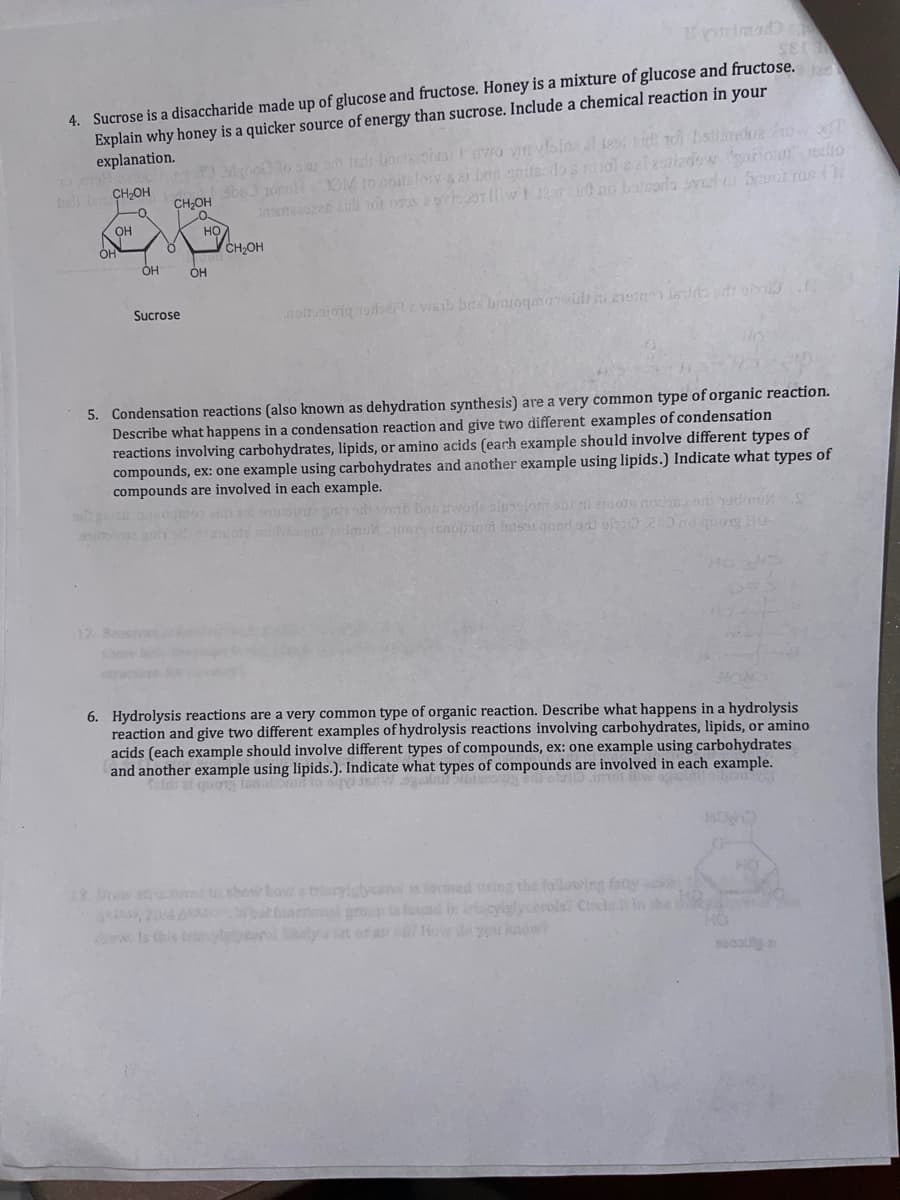4. Sucrose is a disaccharide made up of glucose and fructose. Honey is a mixture of glucose and fructose. Explain why honey is a quicker source of energy than sucrose. Include a chemical reaction in your explanation. u OM 10 odaforv & ar nn anueos rol eieaidew rour io Tlliw CHOH CH,OH но OH CH,OH Sucrose
4. Sucrose is a disaccharide made up of glucose and fructose. Honey is a mixture of glucose and fructose. Explain why honey is a quicker source of energy than sucrose. Include a chemical reaction in your explanation. u OM 10 odaforv & ar nn anueos rol eieaidew rour io Tlliw CHOH CH,OH но OH CH,OH Sucrose
Chemistry & Chemical Reactivity
10th Edition
ISBN:9781337399074
Author:John C. Kotz, Paul M. Treichel, John Townsend, David Treichel
Publisher:John C. Kotz, Paul M. Treichel, John Townsend, David Treichel
Chapter24: Biochemistry
Section: Chapter Questions
Problem 34GQ: The first step of the metabolic process known as glycolysis is the conversion of glucose to glucose-...
Related questions
Question

Transcribed Image Text:4. Sucrose is a disaccharide made up of glucose and fructose. Honey is a mixture of glucose and fructose.
Explain why honey is a quicker source of energy than sucrose. Include a chemical reaction in your
explanation.
CH-OHbo 1oodOM 10 coitaforv &ar bon antndos ruol sleriadow ioiur edio
insmazat ai oi ora oTiliw orido boteorlo vel bouch rus f
td CHOH
HO
OF
CH;OH
OH
OH
Sucrose
5. Condensation reactions (also known as dehydration synthesis) are a very common type of organic reaction.
Describe what happens in a condensation reaction and give two different examples of condensation
reactions involving carbohydrates, lipids, or amino acids (each example should involve different types of
compounds, ex: one example using carbohydrates and another example using lipids.) Indicate what types of
compounds are involved in each example.
HO
12. Bev
show
6. Hydrolysis reactions are a very common type of organic reaction. Describe what happens in a hydrolysis
reaction and give two different examples of hydrolysis reactions involving carbohydrates, lipids, or amino
acids (each example should involve different types of compounds, ex: one example using carbohydrates
and another example using lipids.). Indicate what types of compounds are involved in each example.
18 biaw stniet hosfoaarygyroi is lormed using the fallowing fty
5, 204 taal groslound in irscyiglycerols? Cirele t in he
ww.ls this tryyn y at or a How de you kaow
Expert Solution
This question has been solved!
Explore an expertly crafted, step-by-step solution for a thorough understanding of key concepts.
This is a popular solution!
Trending now
This is a popular solution!
Step by step
Solved in 2 steps with 2 images

Knowledge Booster
Learn more about
Need a deep-dive on the concept behind this application? Look no further. Learn more about this topic, chemistry and related others by exploring similar questions and additional content below.Recommended textbooks for you

Chemistry & Chemical Reactivity
Chemistry
ISBN:
9781337399074
Author:
John C. Kotz, Paul M. Treichel, John Townsend, David Treichel
Publisher:
Cengage Learning

Chemistry & Chemical Reactivity
Chemistry
ISBN:
9781133949640
Author:
John C. Kotz, Paul M. Treichel, John Townsend, David Treichel
Publisher:
Cengage Learning

Chemistry: Matter and Change
Chemistry
ISBN:
9780078746376
Author:
Dinah Zike, Laurel Dingrando, Nicholas Hainen, Cheryl Wistrom
Publisher:
Glencoe/McGraw-Hill School Pub Co

Chemistry & Chemical Reactivity
Chemistry
ISBN:
9781337399074
Author:
John C. Kotz, Paul M. Treichel, John Townsend, David Treichel
Publisher:
Cengage Learning

Chemistry & Chemical Reactivity
Chemistry
ISBN:
9781133949640
Author:
John C. Kotz, Paul M. Treichel, John Townsend, David Treichel
Publisher:
Cengage Learning

Chemistry: Matter and Change
Chemistry
ISBN:
9780078746376
Author:
Dinah Zike, Laurel Dingrando, Nicholas Hainen, Cheryl Wistrom
Publisher:
Glencoe/McGraw-Hill School Pub Co

Chemistry for Today: General, Organic, and Bioche…
Chemistry
ISBN:
9781305960060
Author:
Spencer L. Seager, Michael R. Slabaugh, Maren S. Hansen
Publisher:
Cengage Learning

Chemistry In Focus
Chemistry
ISBN:
9781305084476
Author:
Tro, Nivaldo J., Neu, Don.
Publisher:
Cengage Learning